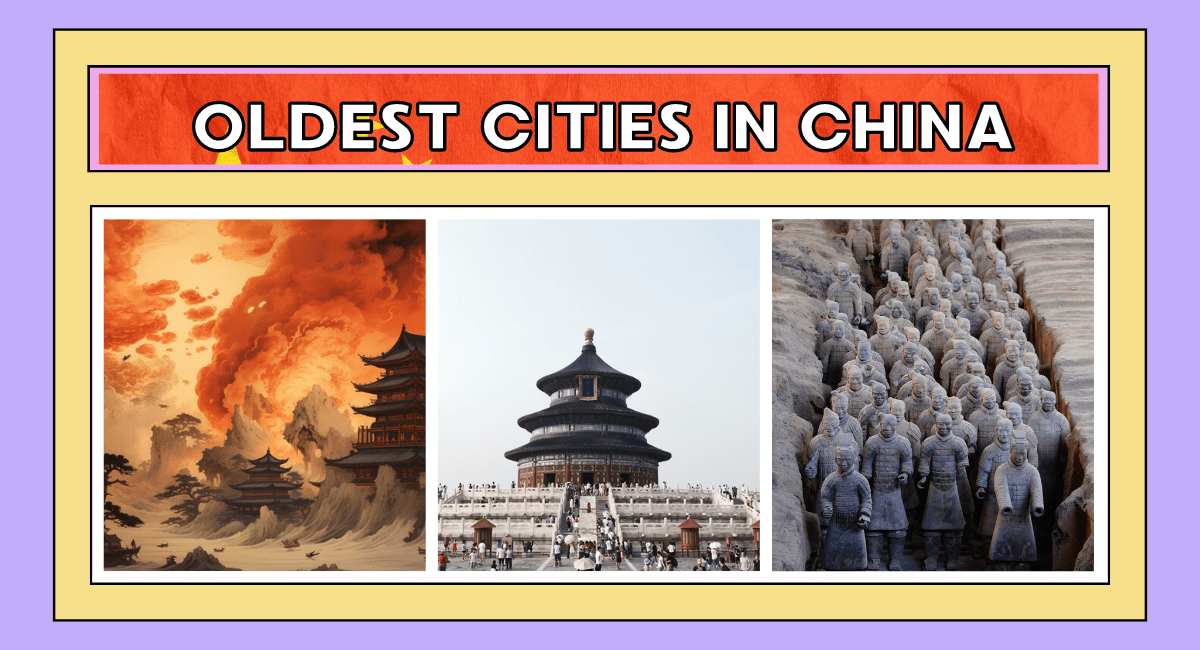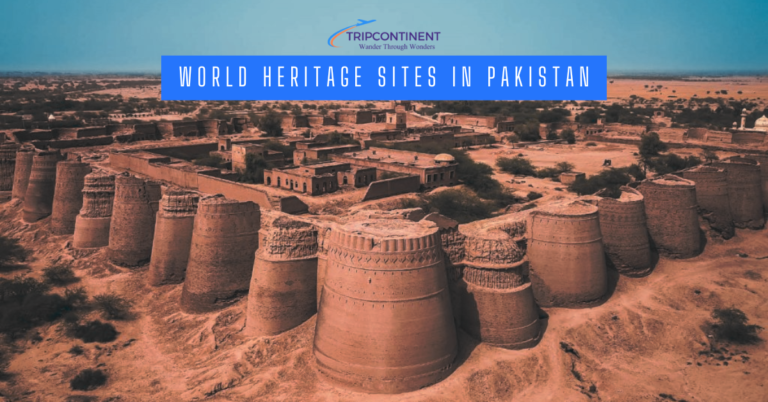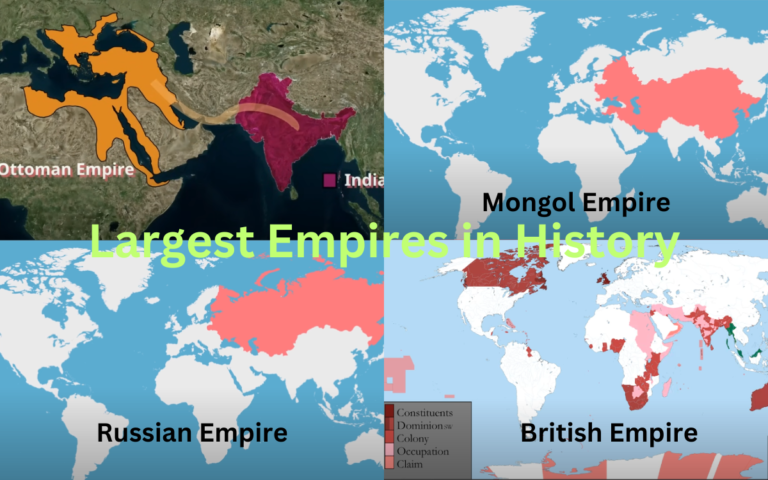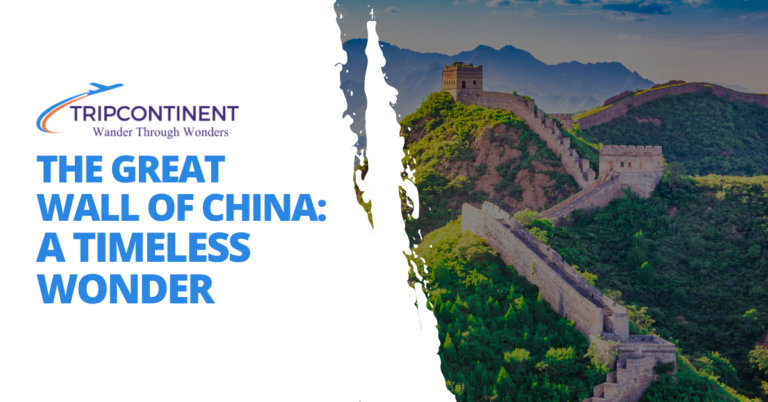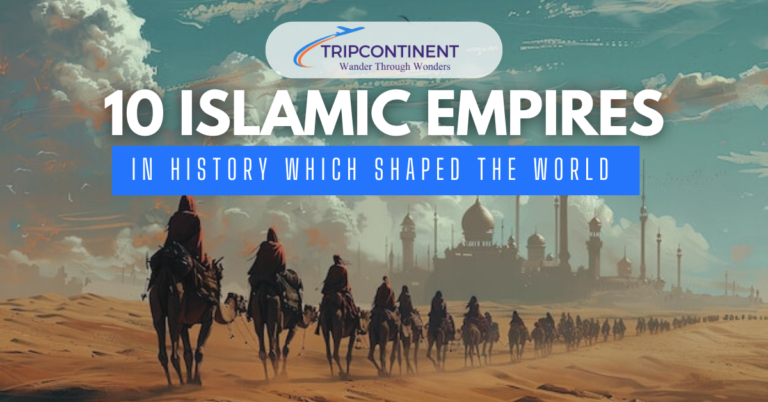Exploring the 10 Oldest Cities in China
China is one of the world’s oldest civilizations, boasting a rich and long history that stretches back thousands of years. Cities that thrived along major trade routes, and rivers or served as capital cities during various dynasties flourished and became centers of culture, commerce, and political power. These ancient cities have carefully preserved their cultural heritage and continue to be important economic and cultural hubs in China today.
Let’s explore some of the oldest cities in China.
List of the Oldest Cities in China
The following is the list of the Oldest Cities in China:
- Lijiang
- The Old City of Shanghai
- Luoyang
- Beijing
- Pingyao Ancient City
- Nanjing
- Kaifeng
- Guilin
- Xi’an
- Hangzhou
1. Lijiang
Lijiang is a gem in China’s Yunnan Province boasting a rich past stretching back over 800 years. The heart of Lijiang is its ancient town, built during the Song Dynasty and thriving under the Yuan Dynasty. This town wasn’t just any town; it was a bustling trading post on the ancient Tea Horse Road, a network of paths where merchants from China, Tibet, and beyond exchanged everything from tea to horses.
But Lijiang’s story goes beyond commerce. It’s the story of the Naxi people, an ethnic group with a culture as unique as their language. The Naxi have a special way of life: their society is led by strong women, and their Dongba religion uses a fascinating pictographic script in ceremonies led by spiritual leaders. These traditions have been passed down for generations, adding a vibrant layer to Lijiang’s identity.
Wherever you wander in Lijiang, the architecture tells a story. Here, influences from the Naxi, Han, and Tibetan people come together to create a one-of-a-kind style. The Old Town, a UNESCO World Heritage Site, is a masterpiece of ancient Chinese urban planning. Canals and bridges snake through the town, while cobbled streets lead you past intricately carved wooden buildings. It all blends seamlessly with the natural beauty of the surrounding area, with the majestic Jade Dragon Snow Mountain standing guard in the distance.
Fast forward to today, and Lijiang has become a magnet for travelers. They come for the charm of the old town, the energy of the Naxi culture, and the breathtaking scenery. Explore the grand Mu Family Mansion, a window into the region’s history. Or head to the Black Dragon Pool for a picture-perfect view of the Jade Dragon Snow Mountain. If you’re feeling adventurous, take a trip to the Tiger Leaping Gorge, one of the deepest in the world.
Lijiang is a city that walks a tightrope between its past and present. It carefully guards its ancient treasures – the Naxi traditions, the architectural wonders – while embracing modern comforts. This unique blend makes Lijiang a truly special place, a captivating destination in China that offers a glimpse into a bygone era alongside the conveniences of today.
Also read: 12 Oldest Cities in the US
2. The Old City of Shanghai
The Old City of Shanghai, also known as the Old Town or Nanshi, has a history that dates back over 1,000 years. It all started humbly as a fishing village during the Song Dynasty, but by the Yuan Dynasty, things were changing. In 1291, it officially became a county, and its location near the Yangtze River Delta, perfect for trade, made it even more important.
The Ming Dynasty saw the Shanghai boom. Cotton became a big deal, and the city’s location made it a trading hub. To keep things safe from pirates, they even built a giant city wall in 1554 – a sign of how important Shanghai had become.
Then came the 19th century, a time of big changes. After the war, foreign trade opened up in Shanghai. This led to foreign settlements popping up, bringing a mix of Chinese and Western styles. Shanghai wasn’t just a port city anymore; it was becoming a fancy, international metropolis.
Today, the Old City is a fascinating mix of old and new. Walk through the Yu Garden, a beautiful Chinese garden built way back in the Ming Dynasty. You can also visit the City God Temple, a Taoist place of worship that’s been around for centuries. The narrow streets lined with traditional shikumen houses feel like a step back in time, a stark contrast to the towering skyscrapers of Pudong nearby.
The Old City isn’t just a history museum, though. It’s a vibrant place to visit. Tourists flock here to soak up the history, admire the architecture, and explore the bustling markets. The area around the Yu Garden is especially interesting, with shops, teahouses, and museums that bring Shanghai’s past to life.
So, the Old City of Shanghai is a reminder of this major Chinese city’s incredible journey. It’s a place that’s both ancient and modern, peaceful and exciting, all at the same time. It’s a must-see for anyone who wants to understand the soul of Shanghai.
3. Luoyang
Luoyang, one of China’s oldest and most historically significant cities, has a history that spans over 4,000 years. It is nestled in Henan Province, considered one of the birthplaces of Chinese civilization. Thirteen dynasties, from Eastern Zhou to Northern Wei, called Luoyang home, making it a central stage for Chinese history for centuries.
Luoyang’s story starts way back in the late Neolithic period, around 2070 BCE when it was a small settlement. By the Eastern Zhou Dynasty (770-256 BCE), things got interesting. Luoyang became the capital, thanks to its perfect location where the Luo and Yi rivers meet. This prime spot made it super important.
Then came the golden age. The Eastern Han Dynasty (25-220 CE) rolled around, and Luoyang became the empire’s capital. The city flourished like never before. This importance continued under the Northern Wei Dynasty (386-534 CE) too, when they chose Luoyang as their capital. This era gifted the world the Longmen Grottoes, a UNESCO treasure trove with thousands of Buddhist statues and carvings – a true testament to Luoyang’s rich culture and religion.
Fast forward to today, Luoyang is a bustling city that hasn’t forgotten its roots. It’s a fantastic blend of old and new. History buffs can geek out over the Longmen Grottoes, the White Horse Temple (the very first Buddhist temple in China, built in 68 CE), and the Luoyang Museum, jam-packed with artifacts from different dynasties. Every year, the city explodes in a riot of colors with the Luoyang Peony Festival, celebrating its beautiful signature flower.
But Luoyang isn’t stuck in the past. It’s a major industrial and transportation hub, playing a key role in China’s central economy. The city has grown and developed without forgetting its history, creating a unique mix of ancient treasures and modern life.
Luoyang’s story is one of lasting power. It’s been a political and cultural hub for ages, and it keeps contributing to China’s growth. From its ancient temples and grottoes to its vibrant festivals, Luoyang is a living link between China’s past and exciting present, making it a must-visit for any traveler.
Also explore: Museums In The USA You Must Explore
4. Beijing
Beijing, China’s capital has a history stretching back over 3,000 years. It all began with a settlement called Ji during the Western Zhou Dynasty. Back then, location was key, and Ji’s spot in northern China made it a vital center for trade and military stuff.
Fast forward to the Yuan Dynasty (think 1271-1368 CE). A ruler named Kublai Khan decided to make Ji the capital, renaming it Dadu. Under his rule, the city boomed, becoming the empire’s heart.
The next big jump came with the Ming Dynasty (1368-1644 CE). Emperor Yongle chose Dadu (now called Beijing) as the capital again. This era saw the building of the Forbidden City, a giant palace complex that’s now a UNESCO World Heritage Site and a must-see for any visitor.
Beijing stayed the capital through the Qing Dynasty (1644-1912 CE) too, and the city kept flourishing. The architecture and layout from this period are still around today, with stunning places like the Summer Palace and the Temple of Heaven reminding visitors of the city’s rich history.
After the Qing Dynasty came the People’s Republic of China, and guess what? Beijing remained the capital!
Today, Beijing is a whirlwind of modern life and ancient history. It’s a major hub for politics, culture, and education, with famous universities like Peking and Tsinghua. The economy is booming too, with everything from finance to tech to manufacturing happening here.
If you’re a tourist, Beijing has something for everyone. Explore the Great Wall, a marvel of human engineering. Visit the Ming Tombs, the resting places of emperors. Stand in Tiananmen Square, a massive public square that’s steeped in history. And if you’re looking for something modern, check out the Bird’s Nest Stadium, built for the 2008 Summer Olympics, or the super cool CCTV Headquarters building.
Beijing’s story is a long one, filled with emperors, revolutions, and even global events like the Olympics. It’s a city that perfectly blends the past with the present, making it a vibrant and dynamic place that continues to be a major player in China’s journey.
5. Pingyao Ancient City
Picture a city frozen in time, a place where ancient China whispers through its streets. That’s Pingyao Ancient City, nestled in Shanxi Province. With a history stretching back over 2,700 years, it’s a living museum of China’s past.
Pingyao’s story began way back in the Western Zhou Dynasty. By the Ming (1368-1644) and Qing (1644-1912) dynasties, it had become a superstar – a key center for trade and finance. The city’s crown jewel is its massive ancient wall, built during the Ming Dynasty. It stretches for over six kilometers, like a giant hug around the city. Watchtowers stand guard every few steps, whispering tales of medieval China’s military might.
Step inside the walls, and it’s like stepping back in time. The city layout hasn’t changed much since the Ming and Qing eras. Narrow streets wind between traditional courtyard houses, and over 300 historical sites dot the landscape. It’s a maze of history waiting to be explored.
Pingyao wasn’t just any city; it was a money mover. During the Qing Dynasty, it became a financial powerhouse, home to the first-ever Chinese bank called “piaohao.” These institutions were the rockstars of their time, handling money transfers and financial dealings across the whole country. The Rishengchang Exchange Shop, built in 1823, was the first of these banks, and today it’s a museum where you can learn all about Pingyao’s financial history.
Fast forward to today, and Pingyao Ancient City is a UNESCO World Heritage Site, recognized for the amazing way it preserved traditional Chinese culture and urban planning. Tourists flock here to wander the historical streets, peek into ancient temples, and marvel at the well-maintained buildings. Must-sees include the Confucian Temple, the Shuanglin Temple, and the City Tower, which offers breathtaking views of the entire old town.
The best part? Pingyao isn’t stuck in the past. It blends its rich history with modern comforts, making it a perfect place to experience Chinese culture. Special events like the Pingyao International Photography Festival add another layer of excitement, attracting artists and photographers from all over the world.
So, Pingyao Ancient City is more than just a place; it’s a journey through time. It’s a reminder of China’s incredible history and a vibrant cultural center that continues to thrive in the modern world.
Also read: Single, Double, And Triple Landlocked States In The USA
6. Nanjing
Nanjing, the capital of Jiangsu Province in China, is an ancient city with a story stretching back over 2,500 years. Its roots reach back to the Spring and Autumn Period (think 770-476 BCE) when it was called Yecheng. Over time, the city changed names and grew in importance, especially during the Qin Dynasty (221-206 BCE).
Nanjing’s star shone brightly during the Three Kingdoms period (220-280 CE). It became the capital of the Eastern Wu Kingdom, and its reputation as a political and cultural center kept growing even after that. It served as the capital for dynasties like the Eastern Jin Dynasty (317-420) and several Southern Dynasties (420-589).
One of Nanjing’s most golden ages came during the Ming Dynasty (1368-1644). The Hongwu Emperor, Zhu Yuanzhang, chose Nanjing as his capital in 1368. During this period, the city boomed. The Ming Palace, city walls, and other grand structures were built. The Nanjing city wall, stretching nearly 35 kilometers, is still one of the world’s longest.
Nanjing wasn’t just important in ancient times; it played a key role in modern Chinese history too. It served as the capital of the Taiping Heavenly Kingdom during the Taiping Rebellion (1851-1864). Later, after the Xinhai Revolution in 1912, Nanjing became the capital of the Republic of China, holding this title until the end of the Chinese Civil War in 1949.
Today, Nanjing is a bustling hub for culture, education, and business. It boasts prestigious universities like Nanjing University and Southeast University. The city’s economy is strong, with a focus on manufacturing, electronics, and software.
If you’re a tourist, Nanjing has something for everyone. Explore the Sun Yat-sen Mausoleum, the Ming Xiaoling Mausoleum, or the Nanjing Massacre Memorial Hall. Head to the Confucius Temple area, where the Qinhuai River scenic area offers a perfect blend of historical sites and modern fun.
Nanjing is a city that wears its history with pride. It carefully guards its past while embracing the modern world. This unique mix makes Nanjing a vibrant and dynamic place, a link between China’s glorious past and its exciting future.
7. Kaifeng
Kaifeng is a city in China that’s seen empires rise and fall over 2,700 years. It is nestled in Henan Province. Its roots go way back to the Warring States Period (475-221 BCE) when it was called Daliang, a capital city for a state called Wei.
Fast forward to the Northern Song Dynasty (960-1127 CE), and Kaifeng became a superstar. Renamed Bianjing, it boomed as the capital, a center of politics, business, and culture. Back then, with over a million people, it was one of the world’s biggest and richest cities! Its location on the Grand Canal, a giant water highway, made trade and communication a breeze, adding to its wealth and exciting cultural scene.
The city was famous for its international vibe, busy markets, and groundbreaking advances in art and science. Even today, you can see reminders of this golden age in landmarks like the Iron Pagoda, built in 1049, a perfect example of Song Dynasty architecture, and the Dragon Pavilion, a royal palace from way back when.
Life wasn’t always easy for Kaifeng. Floods from the Yellow River and invasions by outsiders caused problems over the centuries. The city’s importance dipped after the Northern Song Dynasty fell. New dynasties like the Jin (1115-1234 CE) and Ming (1368-1644 CE) chose different capitals.
Today, Kaifeng embraces its rich history and culture. They’ve put a lot of effort into preserving old sites like the Millennium City Park, a reconstruction of a famous Song Dynasty riverside scene, and the Kaifeng Museum, jam-packed with treasures from the city’s past.
Modern Kaifeng is a bustling city with a growing economy focused on agriculture, textiles, and tourism. They haven’t forgotten their history, though. They celebrate it with festivals and events like the Kaifeng Chrysanthemum Festival, which attracts visitors from all over China.
So, Kaifeng is a fascinating blend of historical significance and modern life. It’s a city that tells the story of China’s past while building its exciting future.
8. Guilin
Guilin is a city in China so scenic that it’s been painted in art and written about in poems for centuries. It is nestled in the Guangxi Zhuang Autonomous Region. With a history of over 2,000 years old, it’s a place where nature and history collide beautifully.
Guilin’s story starts small, with a settlement established during the Qin Dynasty (221-206 BCE). Things grew more interesting under the Han Dynasty (206 BCE-220 CE) when Guilin became a key military and administrative center, thanks to its perfect location. The city even got its beautiful name, “Forest of Sweet Osmanthus,” from all the fragrant osmanthus trees that grew there.
Over time, Guilin kept growing in importance. The Tang (618-907) and Song (960-1279) dynasties saw Guilin rise thanks to its strategic location and stunning scenery. Poets and artists flocked here to capture its beauty in their works.
The real boom came during the Ming Dynasty (1368-1644). Guilin became the capital of Guangxi Province, and the city flourished. This era saw the building of many of Guilin’s must-see landmarks, like the city wall and Solitary Beauty Peak. Guilin became a major player, both politically and culturally.
But what truly sets Guilin apart is its breathtaking landscape. Limestone hills, caves, and the Li River with its iconic beauty have made this a superstar tourist destination. The Li River has been a source of inspiration for Chinese artists and writers for centuries. If you visit Guilin, don’t miss spots like Elephant Trunk Hill, Reed Flute Cave, and the Longji Rice Terraces.
Today, Guilin is still a top tourist spot in China, welcoming millions of visitors every year. The city has modernized itself, but it hasn’t forgotten its natural beauty or historical charm. They’ve made it super easy to get to Guilin with high-speed rail connections, opening the door to even more domestic and international tourists.
Guilin isn’t just about tourism, though. It’s also an educational and cultural hub, with universities like Guangxi Normal University and Guilin University of Technology. The city keeps things exciting with cultural events and festivals, like the Guilin International Tourism Expo, making it a major player in the global tourism world.
So, Guilin is a unique blend of natural wonders, historical significance, and modern comforts. It’s a place that lets you experience both the ancient and modern sides of Chinese culture, making it a truly unforgettable destination.
Also read: Largest Caves In The United States
9. Xi’an
Xi’an, a city in Shaanxi Province, China, is over 3,000 years old. It’s been around for so long that it’s seen countless dynasties rise and fall, and even served as the capital for some of the most important ones, like the Zhou, Qin, Han, Sui, and Tang dynasties. Back in the day, it was called Chang’an, which means “Perpetual Peace.”
Xi’an wasn’t just peaceful, it was also a superstar of trade. Sitting at the eastern end of the Silk Road, it was a key spot for merchants to exchange goods and ideas between China and the West. Imagine a bustling marketplace filled with people from all over Asia and beyond.
The city’s rise to fame began during the Western Zhou Dynasty (think 1046-771 BCE), but it hit its peak under the Qin Dynasty (221-206 BCE). Back then, it was called Xianyang, and Emperor Qin Shi Huang, the first emperor of a united China, decided to make it his capital. That’s also when he built the Terracotta Army, a giant army of clay soldiers guarding his tomb (it’s a UNESCO World Heritage Site, by the way).
Fast forward to the Han Dynasty (206 BCE-220 CE), and Changan became a center for culture and politics. Things kept going strong under the Tang Dynasty (618-907 CE) too. Back then, it was one of the biggest and most international cities in the world, with merchants, scholars, and important people from all over Asia stopping by.
Today, Xi’an is a bustling modern city that still cherishes its ancient past. The old city walls, built during the Ming Dynasty (1368-1644), are some of the best preserved in China and surround the historic city center. You can also visit amazing places like the Big Wild Goose Pagoda, the Bell Tower, and the Muslim Quarter, which shows off Xi’an’s multicultural history.
But Xi’an isn’t stuck in the past. It’s a major hub for education and technology, with universities like Xi’an Jiaotong University. The economy is booming too, with a focus on tech, manufacturing, and tourism. High-speed trains and a modern airport make it super easy to get to Xi’an, making it even more popular with tourists.
So, Xi’an is a unique blend of ancient history, modern energy, and cultural vibrancy. It’s a city that connects China’s glorious past to its exciting future, and with its historical sites, cultural scene, and strong economy, it’s no wonder it continues to be a major player in China.
10. Hangzhou
Hangzhou is a city in China with over 2,200 years of history, a place where ancient beauty meets modern energy. It is also the capital of Zhejiang Province. Its story starts way back in the Qin Dynasty (221-206 BCE) in a small town called Qiantang County. Its location was perfect – right by the Grand Canal, a giant water highway, and close to the East China Sea. This made Hangzhou a natural hub for trade.
Things took off for Hangzhou during the Tang Dynasty (618-907 CE). By then, it had become a superstar of commerce and culture. However, the city’s golden age arrived during the Southern Song Dynasty (1127-1279 CE). Invaders forced the Song Dynasty to move their capital here, renaming it Lin’an. Under the Song, Hangzhou boomed – a center of politics, culture, and business, famous for its wealth and international vibe.
One of Hangzhou’s most famous residents during this period was a poet and governor named Bai Juyi. He helped make the city even more beautiful by promoting the construction of scenic areas around the West Lake. This lake, now a UNESCO World Heritage Site, is like something out of a painting, with its temples, pagodas, and gardens. It’s no wonder the West Lake has been a favorite subject of Chinese writers and artists for centuries.
Today, Hangzhou is a bustling modern city that’s also a major player in the tech world. It’s the headquarters of Alibaba Group, one of the world’s biggest e-commerce companies, which shows how Hangzhou has transformed into a center of innovation. The city’s economy is strong, with a focus on manufacturing, technology, and tourism.
Getting to Hangzhou is a breeze. It has a modern metro system, high-speed rail connections, and an international airport that connects it to destinations all over the world.
If you’re a tourist, Hangzhou has something for everyone. Explore the Lingyin Temple, one of China’s biggest and richest Buddhist temples. Wander through the ancient Hefang Street, or take a boat ride on the West Lake and admire the beauty of Leifeng Pagoda and the Su Causeway. The city also comes alive with cultural events throughout the year, like the West Lake Expo and the Hangzhou International Marathon.
Hangzhou is a city that blends historical significance with stunning natural beauty and modern energy. It’s a place that keeps attracting tourists, business minds, and scholars alike. With its rich heritage and modern achievements, Hangzhou remains a vital cultural and economic center in China.
A Table Comparison of the Oldest Cities in China
| City | Province | Years Old | History |
| Luoyang | Henan | Over 4,000 | Capital during 13 dynasties; home to the Longmen Grottoes |
| Xi’an | Shaanxi | Over 3,000 | Capital during several dynasties; hub for trade and cultural exchange |
| Beijing | Beijing | Over 3,000 | Capital for over 800 years; rich history and cultural significance |
| Nanjing | Jiangsu | Over 2,500 | Capital during multiple dynasties; significant historical and cultural sites |
| Hangzhou | Zhejiang | Over 2,200 | Thriving hub for trade and culture during the Southern Song Dynasty |
| Pingyao Ancient City | Shanxi | Over 2,700 | Dates back over 2,700 years; financial powerhouse during the Qing Dynasty |
| Kaifeng | Henan | Over 2,700 | Capital during the Northern Song Dynasty; major financial and cultural center |
| Guilin | Guangxi Zhuang | Over 2,000 | Settlement during the Qin Dynasty; cultural and scenic significance |
| The Old City of Shanghai | Shanghai | Over 1,000 | Fishing village during the Song Dynasty; trading hub during the Ming Dynasty |
| Lijiang | Yunnan | Over 800 | Established during the Song Dynasty; trading post on the Tea Horse Road |
Conclusion
So, these were the Oldest Cities in China.
Today, these ancient cities are vibrant and modern metropolises that offer visitors a unique blend of history, culture, and natural beauty. Whether you’re interested in exploring ancient temples, strolling through traditional gardens, or marveling at stunning landscapes, China’s oldest cities have something to offer everyone. So, come and discover the magic of these ancient places for yourself.
FAQs
What Is China’s Richest City?
Based on reports from Henley & Partners and wealth intelligence firms, Beijing currently holds the title of China’s wealthiest city.
Which Are the Oldest Cities in the World?
The three oldest cities in the world are Jericho, Palestine; Varanasi, India; and Damascus, Syria.
What Was the First Country in the World?
Ancient Egypt holds a strong claim to being one of the earliest, continuously developing societies in the world. If we consider the unification of Upper and Lower Egypt under King Narmer around 3150 BCE as its founding date, then Egypt has a very strong case for being the oldest country. This marks the beginning of the first dynasty of Egypt and the end of the predynastic period.
Which Country Has No Capital City?
The country with no official capital city is Nauru. It’s a small island nation located in Micronesia, Oceania. Nauru has a capital district instead of a single capital city. Most government functions are carried out in the district of Yaren.
What Is the Largest City in the World?
The largest city in the world by population is Tokyo, Japan. As of 2024, Tokyo’s urban area is estimated to have over 37 million inhabitants. This vast metropolis covers an area of over 13,452 square kilometers and is a major center for finance, business, culture, and technology.

I’m Sophia Jones, an adventurer at heart from New York City, USA. I live for travel and exploration, always eager to discover new places, meet fascinating people, and try out diverse cuisines. Over the past few years, I’ve traveled to numerous countries, immersing myself in different cultures and creating unforgettable memories.
